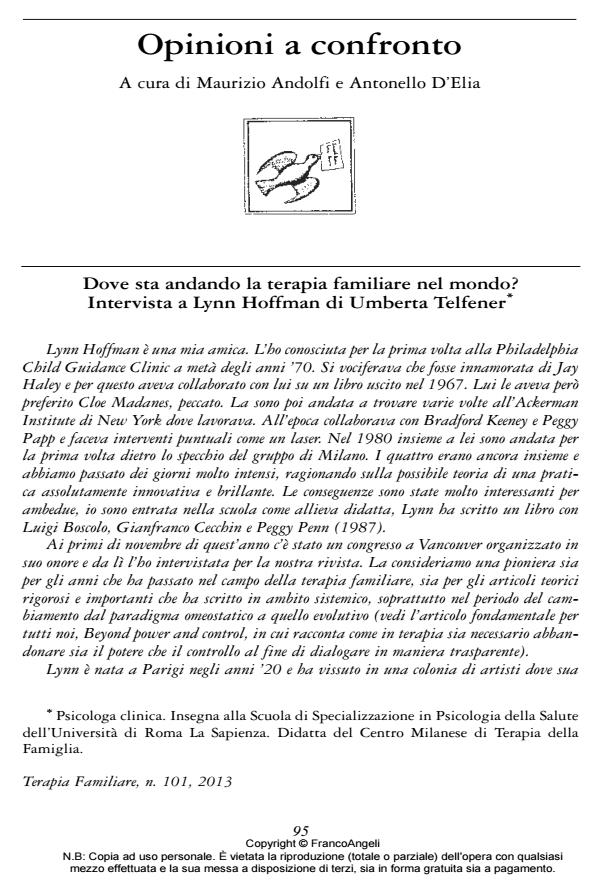Dove sta andando la terapia familiare nel mondo? Intervista a Lynn Hoffman di Umberta Telfener
Titolo Rivista TERAPIA FAMILIARE
Autori/Curatori Umberta Telfener
Anno di pubblicazione 2013 Fascicolo 2013/101 Lingua Italiano
Numero pagine 6 P. 95-100 Dimensione file 100 KB
DOI 10.3280/TF2013-101005
Il DOI è il codice a barre della proprietà intellettuale: per saperne di più
clicca qui
Qui sotto puoi vedere in anteprima la prima pagina di questo articolo.
Se questo articolo ti interessa, lo puoi acquistare (e scaricare in formato pdf) seguendo le facili indicazioni per acquistare il download credit. Acquista Download Credits per scaricare questo Articolo in formato PDF

FrancoAngeli è membro della Publishers International Linking Association, Inc (PILA)associazione indipendente e non profit per facilitare (attraverso i servizi tecnologici implementati da CrossRef.org) l’accesso degli studiosi ai contenuti digitali nelle pubblicazioni professionali e scientifiche
- Boscolo L., Cecchin G., Hoffman L., Penn P. (1987). Milan systemic family therapy. New York: Basic Books.
- Haley J., Hoffman L. (1967) Tecniche di terapia della famiglia. Roma: Astrolabio, 1974
- Hetrick E., Hoffman L. (1981). The Broome Street Network. In: Sanders D.S., Fischer J., Kurken O. (eds.), Foundamentals of social work practice. North Scituate: Duxbury Press.
- Hoffman L. (1971). Deviationamplifying processes in natural groups. In: Haley J. (ed.), Changing families. New York: Grune & Stratton.
- Hoffman L. (1975). Enmeshment and the too richly cross-joined system. Family Process, 14: 457-468
- Hoffman L. (1976). Breaking the homeostatic cycle. In: Guerin P. (ed.), Family therapy. New York: Theory and Practice, Garner Press.
- Hoffman L. (1980). The family life cycle and discontinuous change. In: Carter E., Orfanides M. (eds.), The family life cycle. New York: Garner Press
- Hoffman L. (1981), Foundations of family therapy. New York: Basic Books
- Hoffman L. (1983). Un modello evolutivo per la terapia familiare sistemica. In: Malagoli Togliatti M., Telfener U. (a cura di), La terapia sistemica. Roma: Astrolabio.
- Hoffman L. (1985). Beyond power and control. Family Systems Medicine, 3: 381-396
- Hoffman L. (1993). Exchanging voices. London: Karnac Books
- Hoffman L. (1998). Setting aside the model in family therapy. Family Process, 24: 145-156.
- Hoffman L. (2000). A communal perspective for the relational therapies. In: Olson M. (ed.), Feminism, community and communication. Birghamton: Haworth.
- Hoffman L. (2002). Family therapy, an intimate history. New York: Norton
- Hoffman L., Long L. (1969) A systems dilemma. Family Process, 8: 211- 234
- Hoffman L., Davis J. (1993) Tekka with feathers. In: Friedman S. (ed.), The new language of change. New York: The Guilford Press.
- Alexander C. (1964). Note sulla sintesi della forma. Milano: Il Saggiatore, 1967
- Andersen T. (1991). The reflecting team. New York: Norton
- Bachtin M.M. (1975). Estetica e romanzo. Torino: Einaudi, 1979
- White M. (1992). La terapia come narrazione. Roma: Astrolabio
- Whitaker R. (2005). Anatomy of an epidemic: psychiatric drugs and the astonishing rise of mental illness in America. Ethical Human Sciences and Services, 7, 1: 23-35.
- Shotter J. (1997). The social construction of our “inner” lives. Journal of Constructivist Psychology, 5: 49-73.
- McGoldrick M. (1998). Re-visioning family therapy: race, culture and gender in clinical practice. New York: Guildford
- Kinman C. (2011). The language of gifts. Canada: Rhizome productions
- Gilligan C. (1982). In a different voice. Cambridge: Harvard Univ. Press
- Foerster von H. (1987). Sistemi che osservano. Roma: Astrolabio
- de Shazer S. (1994). Words were originally magic. New York: Norton
- Deleuze G., Guatarri F. (1980). Millepiani, capitalismo e schizofrenia. Roma: Castelvecchi, 2010.
Umberta Telfener, Dove sta andando la terapia familiare nel mondo? Intervista a Lynn Hoffman di Umberta Telfener in "TERAPIA FAMILIARE" 101/2013, pp 95-100, DOI: 10.3280/TF2013-101005